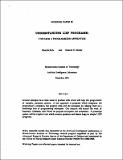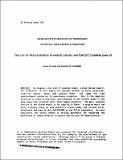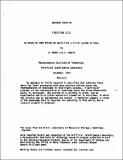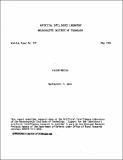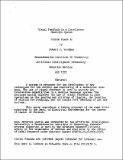Browsing AI Working Papers (1971 - 1995) by Title
Now showing items 262-281 of 291
-
Understanding LISP Programs: Towards a Programmer's Apprentice
(MIT Artificial Intelligence Laboratory, 1974-12)Several attempts have been made to produce tools which will help the programmer of complex computer systems. A new approach is proposed which integrates the programmer's intentions, the program code, and the comments, by ... -
Understanding Scenes With Shadows
(MIT Artificial Intelligence Laboratory, 1971-11)The basic problem of this research is to find methods which will enable a program to construct a three dimensional interpretation from the line drawing of a scene, where the scene may have shadows and various degeneracies. ... -
The Use of Dependency Relationships in the Control of Reasoning
(MIT Artificial Intelligence Laboratory, 1976-11)Several recent problem-solving programs have indicated improved methods for controlling program actions. Some of these methods operate by analyzing the time-independent antecedent-consequent dependency relationships between ... -
The Use of Thread Memory in Amnesic Aphasia and Concept Learning.(note 0)
(MIT Artificial Intelligence Laboratory, 1979-09-05)We propose a new type of semantic memory, called thread memory. The primitives of this memory are threads, defined as keyed multilink, loop-free chains, which link semantic nodes. All links run from superordinate categories ... -
A User's Guide to the AI Lab: Getting Started at Tech Square
(MIT Artificial Intelligence Laboratory, 1991-08-18) -
Using Message Passing Instead of the GOTO Construct
(MIT Artificial Intelligence Laboratory, 1978-04)This paper advocates a programming methodology using message passing. Efficient programs are derived for fast exponentiation, merging ordered sequences, and path existence determination in a directed graph. The problems ... -
Using the PUMA System
(MIT Artificial Intelligence Laboratory, 1985-04)This document describes the operation of the Lisp Machine interface to the Unimation Puma 600 Robot Arm. The interface is evolved from a system described in an earlier paper, and much is the same. However, the under-lying ... -
Using the Vidisector and the Store Picture Facility
(MIT Artificial Intelligence Laboratory, 1972-06)The stored picture facility (FAKETV) allows LISP users, and to some extent machine language users, to access a library of stored images rather than live vidisector scenes. The vidisector functions in LISP have been slightly ... -
Video Ergo Scio
(MIT Artificial Intelligence Laboratory, 1973-11)An approach to vision research is described that combines ideas about low level processing with more abstract notions about the representation of knowledge in intelligent systems. A particular problem, of the representation ... -
Views on Vision
(MIT Artificial Intelligence Laboratory, 1971-02) -
Virtual Inclusion
(MIT Artificial Intelligence Laboratory, 1983-09)Several recent knowledge-representation schemes have used virtual copies for storage efficiency. Virtual copes are confusing. In the course of trying to understand, implement, and use Jon Doyle's SDL virtual copy mechanism, ... -
VISHEM: A bag of "robotics" formulae
(MIT Artificial Intelligence Laboratory, 1972-12)Here collected you will find a number of methods for solving certain kinds of "algebraic" problems found in vision and manipulation programs for our AMF arm and our TVC eye. They are collected here to avoid the need to ... -
A Vision Potpourri
(MIT Artificial Intelligence Laboratory, 1972-06)This paper discusses some recent changes and additions to the vision system. Among the additions are the ability to use visual feedback when trying to acurately position an object and the ability to use the arm as a sensory ... -
Vision Review
(MIT Artificial Intelligence Laboratory, 1978-05) -
Vision Utilities
(MIT Artificial Intelligence Laboratory, 1985-12)This paper documents a collection of Lisp utilities which I have written while doing vision programming on a Symbolics Lisp machine. Many of these functions are useful both as interactive commands invoked from the Lisp ... -
Visual Feedback in a Coordinated Hand-Eye System
(MIT Artificial Intelligence Laboratory, 1972-08)A system is proposed for the development of new techniques for the control and monitoring of a mechanical arm-hand. The use of visual feedback is seen to provide new interactive capabilities in a machine hand-eye system. ... -
Visual Position Extraction Using Stereo Eye Systems with a Relative Rotational Motion Capability
(MIT Artificial Intelligence Laboratory, 1972-01)This paper discusses the problem of context-free position estimation using a stereo vision system with moveable eyes. Exact and approximate equations are developed linking position to measureable quantities of the image-space, ... -
Visual Tracking of Real World Objects
(MIT Artificial Intelligence Laboratory, 1975-07)This paper describes the progress made towards tracking an object visually using a PIN diode attached to a dual mirror deflection system which enables the PIN diode to "optically point" to any position in two-space. A ... -
Wait-and-See Strategies for Parsing Natural Language
(MIT Artificial Intelligence Laboratory, 1974-08)The intent of this paper is to convey one idea central to the structure of a natural language parser currently under development, the notion of wait-and-see strategies. This notion will hopefully allow the recognition of ... -
Wandering About the Top of the Robot
(MIT Artificial Intelligence Laboratory, 1971-07)Part I of this paper describes some of the new functions in the system. The discussion is seasoned here and there with parenthetical code fragments that may be ignored by readers unfamiliar with PLANNER. Part II discussed ...

